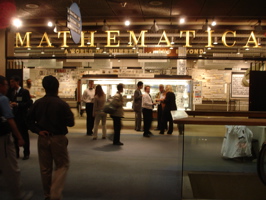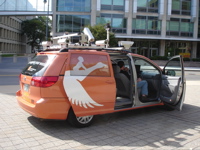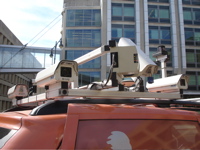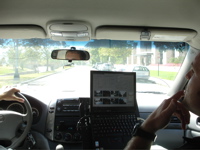John is leaving
This is not a “best thing”, but it feels momentous… John Maeda is leaving the Media Lab. He’s off to RISD at the end of the month.
John gives his last lecture this Friday, 3:30pm, in Bartos. His students made some awesome posters to commemorate his time here.

TED Talks
(My last post was almost two months ago! I never intended to neglect “best thing” for so long, but all I can say is that I have been very busy. And now I have learned that the momentum of pausing a thing like this can be ridiculously self-maintaining… as I suppose momentum tends to be. Argh.)
Tonight I realized that my best professor friend ever, Deborah Gordon, gave a TED Talk back in 2003 about her work on ants. The video has just been posted on the TED Talks site. It’s a great introduction to a very interesting subject, and I count myself as lucky to have participated in the exact bits of tedious work she describes in that talk. If you haven’t seen her speak before, you’ll get to see some of her characteristic say-it-exactly-how-it-is-but-somehow-it’s-funny comments.
In other news, my current advisor, Tod Machover, will be speaking at this year’s TED conference. So I’ll be looking out for that one.
…And one more, from last year, by our soon-to-be-departed (a.k.a. soon-to-be-much-missed), TED-regular John Maeda.
Want to set up a wiki really easily?
 I just set up a wiki in perhaps a little more than 12 seconds, for our class, using pbwiki. Highly recommended for wikis for all occasions!
I just set up a wiki in perhaps a little more than 12 seconds, for our class, using pbwiki. Highly recommended for wikis for all occasions!
“It’s as easy as a peanut butter sandwich.” (And has the added benefit of making me hungry.)
Thanks to K for this recommendation… she says she uses it for her personal notes for work, and she can edit them anywhere she has an internet connection. A great idea.
“Helvetica rejected Sonic Youth.”
I just had the pleasure of watching Helvetica, a film about the font, typography, and the wide range of deep responses we can have to the way we write our letters in space. It is a great movie; go see it if you can.
Director Gary Hustwit was there with us, answering questions after the show. The funniest part was him describing how he got the music for the film (“What does Helvetica sound like??”), most of which was straight from the iTunes playlist he was listening to at the time he conjured up the idea for the film. (Think Four Tet, Caribou, Sam Prekop.) He’s got a background producing music documentaries, so has plenty of connections.
Hustwit says he even got five unreleased, instrumental tracks from Sonic Youth, for him to use in the film. But the tracks just wouldn’t fit, no matter how hard he tried. “Helvetica rejected Sonic Youth.”
The way that this statement makes so much sense is… indescribable to me, and utterly satisfying.
Eating dinner at the Museum of Science
 Last night’s catered Media Lab sponsor dinner was at the Museum of Science. I can’t tell you how funny it is to be playing with an exhibit, pressing buttons to adjust the speed of an animated school of fish, and have someone step up to you with a tray of treats and say, “Spanakopita bite?”
Last night’s catered Media Lab sponsor dinner was at the Museum of Science. I can’t tell you how funny it is to be playing with an exhibit, pressing buttons to adjust the speed of an animated school of fish, and have someone step up to you with a tray of treats and say, “Spanakopita bite?”
My favorite exhibit, hands down, is the “Mathematica” exhibit, which, I just learned, was designed by Charles and Ray Eames. Figures.

My favorite part of that exhibit is the Hyperboloid of Revolution. It’s beautiful and elegantly simple. (short video — 6.5 MB)
The sign says:
HYPERBOLOID OF REVOLUTION
It is an interesting fact that a moving straight line can describe the exact shape of a surface with compound curvature.
This model is a demonstration of a line sweeping out the surface of a hyperboloid. The curved slot is a profile of the surface, called a hyperbola.
Preparing for the Thesis
This afternoon was 3.5 hours of “rapid-fire”, “elevator-pitches” in the Media Lab’s Thesis Preparation course. So all 33 of the 2nd-year Masters students presented in 3 minutes what they hope to do for their Masters work this year.
The best part of an activity as draining as this is to walk away from it knowing that tons of awesome stuff is going to happen in the lab this year.
Here are some of the projects we can all look forward to:
- Programmable Matter — little cube automata that can be programmed to move relative to each other with electromagnetics.
- Cross-cultural Music Transformation — a translator for one culture’s musical style into another.
- Hi-Res, Low-cost Holographic Video
- “Comm.unity” — A platform that learns our social relationships and uses those to enable easy transfer of data between mobile devices in our social network.
- “Intelligent Stickies” — ink recognition, location awareness, and commonsense knowledge in Post-its.
- Investigating the placebo effect in active medicines — How does the packaging/branding change the effectiveness of a drug?
- Transforming digital content as it is copied and shared. Exploring making digital media more like analog media, which bears traces of previous usage.
- Wearable, wireless sensing for sports medicine, specifically for baseball pitchers.
- “E15” — a new way to browse the web.
- A digital platform for creation of interactive art in a networked environment.
- Persuasive Robotics — How can robots affect our attitude and behaviors? How is robot-human interaction different from human-human interaction?
“Visual Music” lecture
I gave my first lecture today. It was a 2.5-hour class on visualizing music, part of the Musical Aesthetics & Media Technology class I am TA-ing.
I spent much of the last few days preparing for this, and I found some impressive examples of visualizing music from the past few hundred years. In fact, there were so many examples that one of the hardest parts of preparing for the talk was defining its scope. I chose the examples I thought were most relevant to telling my version of the story, including Klee, Kandinsky, Oskar Fischinger, the Whitney brothers, Fantasia, all the way up to Ratatouille, the Music Animation Machine, and Martin Wattenberg’s The Shape of Sound. You can see all of these here, in my presentation:

Click image above to download interactive QuickTime slideshow (4.2 MB)
Underlined texts are link-outs, and you can use arrows to navigate through the show.
My favorite example of all is Oskar Fischinger’s Allegretto, which blew me away. Unfortunately I can’t find this online, but there is a fantastic DVD with that video available here.

(Tomorrow or Friday I will follow up with a set of links that cover the best examples of visual music that I found, including a couple of killer blog finds. That set will be much larger than what I was able to cover in class today.)
Mapping your world
 Tele Atlas held a workshop at the Media Lab today, and I got to go on a ride in one of their “mobile mapping vans”. They drive up and down the streets of major cities and highways in this van, which is equipped with several cameras and laser range-finders on the roof, with a GPS receiver and a rack of memory on the inside. Tele Atlas uses the imagery and distance data to help enhance and texture their new 3D maps, which nicely represent the shapes and appearance of the buildings along the streets.
Tele Atlas held a workshop at the Media Lab today, and I got to go on a ride in one of their “mobile mapping vans”. They drive up and down the streets of major cities and highways in this van, which is equipped with several cameras and laser range-finders on the roof, with a GPS receiver and a rack of memory on the inside. Tele Atlas uses the imagery and distance data to help enhance and texture their new 3D maps, which nicely represent the shapes and appearance of the buildings along the streets.
I climbed in next to the rack, in the only back seat, while my two friendly mapper-driver-dudes took me on a 5-minute ride around MIT, so that I could see the cameras in action. They have cameras on the roof, pointing to either side of the van, and two angled up at about 45º to get snapshots of taller buildings. They also have a “spherical” camera called a Ladybug, which has five cameras arranged in a ring, in a red housing. On either side of the roof are laser range-finders that map out the building layouts and shape as viewed from the road. (I love that the laser manufacturer is named SICK, and that they display this proudly on their devices.)
The guy in the passenger seat looks at maps and camera feeds on a pole-mounted laptop next to the seat, adjusting apertures and directing the driver to roads they have not yet covered. He’ll also mark a road if it’s under construction or one-way.
It seems slow-going; the van can’t take measurements if it travels above 33 mph. This guy’s been working with his partner to map Boston and Cambridge since the beginning of August. They’ll finish in the next week or two, and then move on to another city. I asked him how long it takes to map an area, and he tells me, “It depends on the traffic… Yesterday it was really bad in the Back Bay and Brookline, so we only covered about 75 kilometers in 6 hours.” On a good day, his best, they covered 170 km (106 mi).
Let the geo-nerditry commence!





How much do I move when I sleep?
For my final project for sensors class, I wore accelerometers on my head, arm, and leg for a full night’s sleep, and tried to track how much I moved during the night, and which positions I tend to sleep in.
Main findings:
- I’m a side sleeper.
- I like staying in one position for about 40 minutes at a time.
- That period of time gets shorter as I sleep longer.
I wrote up some quick notes about the project here.
Riding a Segway
I spent almost all of my day at the Media Lab’s h2.0 bonanza, where we (in Frank Moss‘s words) explore what happens “when people begin to merge with the technologies they’ve created”. And I have all kinds of things to say about the crazy shit I saw, both good and bad, but I’ll have to write about that later. For now, I just want to say that I got to try a Segway for the first time today!
I only got about 60 seconds on the thing, and it went something like this:
0-7 seconds: Complete mistrust of the machine. “This thing is totally going to fall over.” I lean, start feeling like I will fall, then overcorrect, resulting in a jerky forward motion. Forward, stop, forward, stop, f-f-forward… backwards… stop.
8-20 seconds: “Ok, maybe not. Ohhhh, I see… I can… yeah! Lean forwards, lean back. Hey, this is kinda cool.”
21-60 seconds: GLEE!
